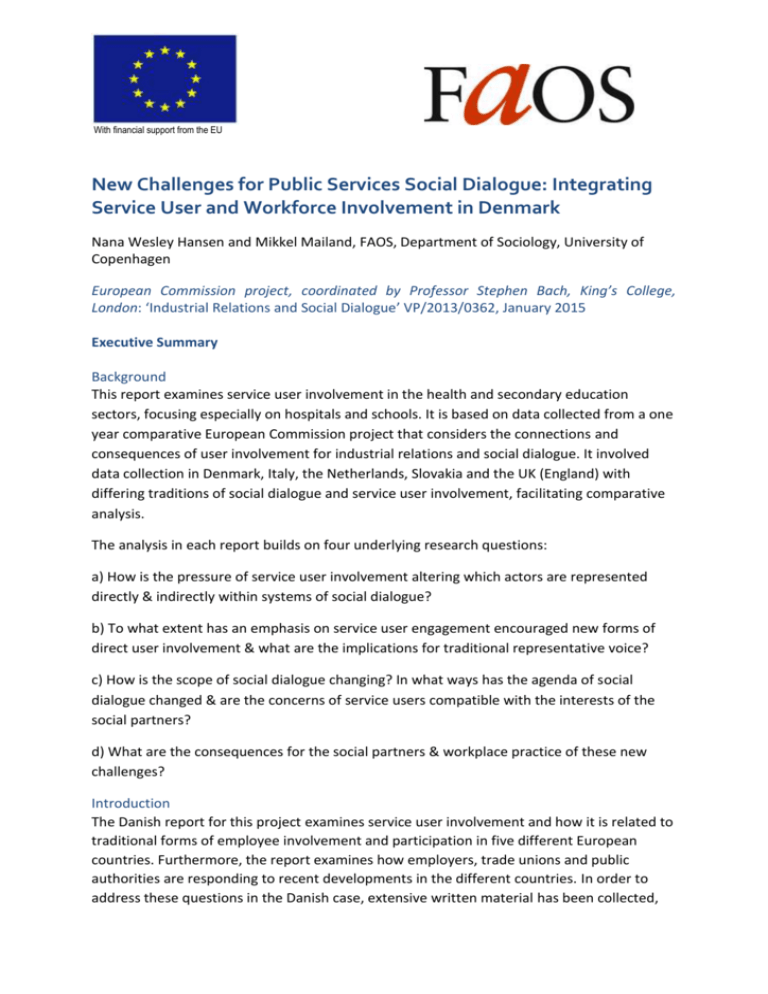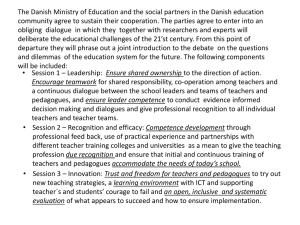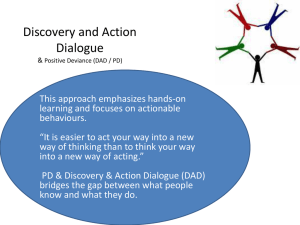Date - King`s College London
advertisement

With financial support from the EU New Challenges for Public Services Social Dialogue: Integrating Service User and Workforce Involvement in Denmark Nana Wesley Hansen and Mikkel Mailand, FAOS, Department of Sociology, University of Copenhagen European Commission project, coordinated by Professor Stephen Bach, King’s College, London: ‘Industrial Relations and Social Dialogue’ VP/2013/0362, January 2015 Executive Summary Background This report examines service user involvement in the health and secondary education sectors, focusing especially on hospitals and schools. It is based on data collected from a one year comparative European Commission project that considers the connections and consequences of user involvement for industrial relations and social dialogue. It involved data collection in Denmark, Italy, the Netherlands, Slovakia and the UK (England) with differing traditions of social dialogue and service user involvement, facilitating comparative analysis. The analysis in each report builds on four underlying research questions: a) How is the pressure of service user involvement altering which actors are represented directly & indirectly within systems of social dialogue? b) To what extent has an emphasis on service user engagement encouraged new forms of direct user involvement & what are the implications for traditional representative voice? c) How is the scope of social dialogue changing? In what ways has the agenda of social dialogue changed & are the concerns of service users compatible with the interests of the social partners? d) What are the consequences for the social partners & workplace practice of these new challenges? Introduction The Danish report for this project examines service user involvement and how it is related to traditional forms of employee involvement and participation in five different European countries. Furthermore, the report examines how employers, trade unions and public authorities are responding to recent developments in the different countries. In order to address these questions in the Danish case, extensive written material has been collected, and 20 semi-qualitative interviews were conducted. The interviews cover the hospital and school sector at three government levels including national sector level, regional/municipal level and the level of the local organisational units. The written sources range from Danish legislation, official government documents, newspaper articles, reports from public authorities and various organisations and secondary literature. After the introduction, the second section of the national report focuses on the emergence of service user involvement in Denmark. This is followed by two sections mapping the development of social dialogue and user involvement. Within each section the developments for the school and hospital sector is compared. This is followed by presentation of a school and a hospital case illustrating user involvement in practice, and how it relates to the social dialogue at the workplace. Finally, an overall conclusion comparing the two sectors is presented. The conclusion directly answers the four research questions concerning the Danish case. The conclusion is followed by a brief discussion of possible explanations for sector variation and similarity found within the Danish case. The report will tell two quite different stories about the state and development of service user involvement in two areas of the Danish public sector, namely the Folkeskolen (Danish municipal primary and lower secondary school) and the hospitals. This difference is in itself an important finding. It reflects the strong divisions within the Danish public sector, also when it comes to user involvement. Although the differences between the ‘sectors’ might be more striking than the similarities, there are empirical ground for overall conclusions related to the four research questions covering both sectors. Explaining the variation Regarding hypotheses on the differences between the two sectors three factors are discussed: Firstly, the provider-user relationship and what can be called the ‘dominant governance ideology’ is different in the two sectors. Folkeskolen has for more than a century been about more than providing children with qualifications and competences. Folkeskolen has been embedded in a project to raise children as citizens in a participatory democracy. To do so Folkeskolen has itself developed along principles of participatory democracy, included direct as well as indirect forms of service user involvement. The hospitals have not been part of such a democratisation project. Secondly, the history and powers of the user organisations is to some extent different in the two sectors, which might also be a factor to consider. In Folkeskolen the National Association of School Parents was formed in 1935 and was for a long time the only national-wide user organisation dealing with more than a single issue. In the hospital sector, few user organisations are old, but most are new. However, differences in the organisational capacity and power of the user-organisations between the two sectors do not seem to be an explanatory factor, since the user organisations in the school sector cannot be said to be stronger than in the hospital sector. Thirdly, the powerrelation between trade unions and user organisations is a factor that potentially could be an important explanatory factor for the different patterns of user involvement. However, this 2 does not seem to be case, since the trade unions in both sectors are strong, professionbased organisations. Hence, there is little variation to also support this hypothesis. Divers of user involvement Firstly, some form of user involvement has existed for a very long time in both sectors and user organisations have existed in both sectors since the first half of the 20th century. Hence, service user involvement is not something new in Denmark as such. However, to varying extent service user involvement is increasing in both sectors in depth (how deep the involvement is) and/or scope (how many areas that are covered). Although direct user involvement in some forms – for instance the direct talks with patients – have a very long history, the indirect forms of service user involvement and some forms of direct user involvement are only a few years old in the hospitals whereas most forms of user involvement in Folkeskolen have a long history and are well institutionalised. The ‘hub’ of user involvement in Folkeskolen, the School board, for instance, was introduced in 1934 as Parents Councils and received its present form and name in 1989. This is not to say that no new development of service user involvement in Folkeskolen is taking place. As described, the School reform from 2013 has formally provided the School boards with extended power. Moreover, the case study illustrates that new forms of user involvement in connection to new challenges and developments are established. Forms of service user involvement Most forms of user involvement in the two sectors are situated in our continuum somewhere between consultation and partnership, possibly most often leaning towards the former. Whereas, the social dialogue processes are more often of the partnership type than the consultation and information types. The social dialogue processes are strongly institutionalised in both sectors, although they face challenges, especially in the school area. However, apart from these general similarities, there are differences in the approach of the social partners. Whereas the employers’ organization in the two sectors – Local Government Denmark and Danish Regions – have embraced user involvement more or less wholeheartedly, the trade union in the school sector – Danish Teachers Union – is so far clearly more engaged in user involvement issues than the trade unions in the hospital sector, although also the Danish Teachers Unions have reservations regarding some forms of service user involvement – especially the more direct forms resembling performance measurement. That the trade unions in the hospital sector so far have not chosen to - or managed to – become a core actor in service user involvement in the hospital area, does not necessarily mean that this will also be so in the future. If user involvement continues to grow in scope and depth, trade unions might try to enter the scene much more forcefully than at present. This can either be to exploit a new platform for influence, or – as the plans to involve user is in the recruitment process from the case hospital illustrate – because user involvement moves closer to the trade unions traditional core business. 3 Social dialogue and user involvement Service user involvement does in general take place in different fora and form different decision-making arenas than do the various forms of social dialogue. There seems to be more multipartite fora with participation of both social partners and service users in the school sector than in the hospital sector. Put differently, service users and social partner representatives meet more often in Folkeskolen than they do in the hospital sector. One possible explanation that service user involvement and social dialogue does not mix is that social dialogue, despite the challenges described, is strong and institutionalised. The social dialogue actors have a monopoly of regulating wages, employment and working conditions and have no interest in giving up on these. Moreover, they have no incentives to do so, since service user involvement is primarily related to other issues than wages, employment and working conditions, and there is limited pressure from the service user to get involved in these issues. That said, some overlap is found in the form of multipartite fora where social partners and user representatives meet, as especially the school sector illustrates. Consequences for the social partners and workplace practice The impact on user involvement on social dialogue and vice-versa is so far very limited. Service user involvement is adding to, rather than replacing, social dialogue in the sectors analysed. Moreover, the impact on workplace conditions seems so far also to be limited. However, consequences for workplace practices can be found which the national report addresses in more detail. 4








